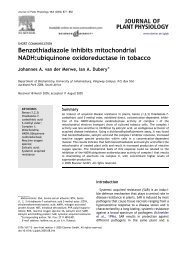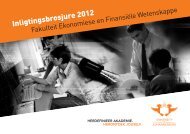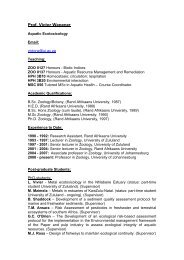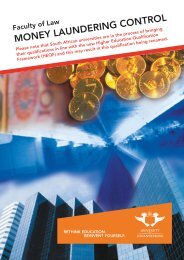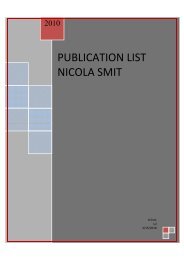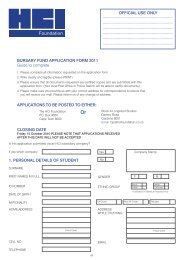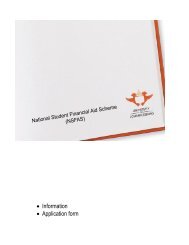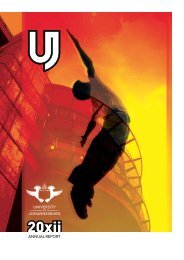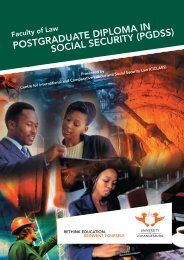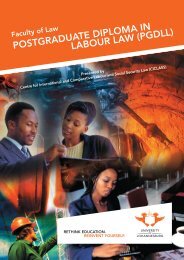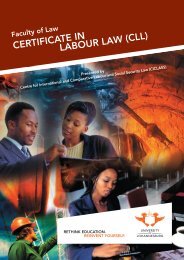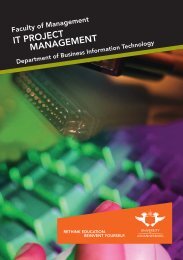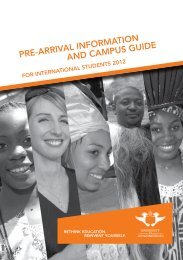De Rebus 7 Reg TM.pdf
De Rebus 7 Reg TM.pdf
De Rebus 7 Reg TM.pdf
You also want an ePaper? Increase the reach of your titles
YUMPU automatically turns print PDFs into web optimized ePapers that Google loves.
THE REGISTRATION OF TRADE MARKSThe registration of trade marks is governed by the provisions of the Trade Marks Act 194 of 1993. Theimportant criterion for registration is whether a mark is capable of distinguishing the goods of one traderfrom those of another (section 9(1)). It is however clear that before this aspect can be evaluated, theremust be certainty that the matter qualifies as a “trade mark”, in terms of the Act. The Act defines “mark”in section 2 to include any sign capable of being represented graphically. The requirement that a markmust be capable of being represented graphically is intended to provide legal certainty regarding thescope of rights brought about by a particular mark‟s registration.It is not always a simple matter though to “pin down” as dynamic an item as a trade mark. One of thereasons is the fact that a trade mark can relate to a number of human senses. First, of course, is matterthat can be seen. “Visible” trade marks can be words such as SANLAM, NINTENDO, or NATIONALGEOGRAPHIC. In some of these and other instances the words can be combined with a logo, such asthe standard bearer of STANDARD BANK, the mountain and stars used with VIACOM, and the horseand rider used with POLO. In some instances, the marks of more than one proprietor can be used inrelation to the same product, such as the trade marks in the photo, used alongside the FREE STATECHEETAHS mark. It can be an interesting exercise to work out what type of rights the various parties allderive from this co-branding venture (see, in general, SAFA v Stanton Woodrush (Pty) Ltd [2003] 1 All SA274 (SCA)). Marks that are visual need not be stationary. An example is a mark consisting of a mantapping his nose, used in relation to financial services, which has been registered in the United Kingdom.Marks can be letters, such as MTV, HTH, or CBS. Surnames can also constitute trade marks, and someof the most famous marks in the motoring world, for instance, actually have surnames as their origin.Examples here are Andre Citroën, Louis Chevrolet, and Shozo Kawasaki. The shape of a product, suchas a container for liquids, can also be a trade mark.In terms of the Act, colours can also be trade marks. This aspect is controversial however. The <strong>Reg</strong>istrarof Trade Mark‟s practice in the past has been to accept applications for colours on their own, withoutreference to a device or logo of some kind, and in those instances an applicant would, for example,simply file two blocks containing the colours. This practice was changed after the decision in Cadbury Ltdv Beacon Sweets & Chocolates (Pty) Ltd 2004 BIP 74 (R<strong>TM</strong>). In this case application was made forregistration of “the colour purple” in relation to labels or packaging for chocolate. A representation of thecolour accompanied the application. Later it was attempted to include an endorsement to refer to aPantone number, which is an international colour classification system. Spoelstra J referred to thedecision of the European Court of Justice (ECJ) in Libertel Groep BV v Benelux-Merkenbureau [2004]FSR 465. Here application was made for registration of the colour “orange” in relation to communicationservices. The following was said in the latter decision (paragraphs 26-27):“Accordingly it is for the Court to determine whether art 2 of the Directive is to be interpreted asmeaning that a colour per se is capable of constituting a trade mark. In that regard it must bepointed out that a colour per se cannot be presumed to constitute a sign. Normally a colour is asimple property of things. Yet it may constitute a sign. That depends on the context in which thecolour is used. None the less, a colour per se is capable, in relation to a product or service, ofconstituting a sign.”In the Beacon case, Spoelstra J, after referring to the above passage, then (page 83 A-B) stated thefollowing:“I understand the above statement to mean that a colour can only constitute a sign or a mark if itis used in a proper context. If this is a correct rendering of that court's view, one can hardlydisagree with it. In other words, the colour must be used or applied as a mark in some or otherwell-defined form. This is a far cry from stating that colour, in isolation, without being used in adistinct fashion, constitutes a mark. If used as a mark, colour must be 'represented visually,particularly by means of images, lines or characters, so that it can be precisely identified' (ibid[Libertel] at para 28) and 'the graphic representation must be clear, precise, self-contained, easilyaccessible, intelligible, durable and objective' (ibid para 29).”
3reputation through use. Sections 10(15)-(16) deal with the opposition of a later application, or an earlierapplication where the opponent has existing rights (such as a restraint of trade). A mark can be opposedin terms of section 10(14), where it is to be used in relation to goods the same as or similar to an existingregistered mark, and where there is a likelihood of confusion. Lastly, section 10(17) provides for anopposition in the case of an application for the registration of a confusingly similar mark, the use of whichwould be likely to take unfair advantage of, or be detrimental to, the distinctive character or repute of awell-known (or rather famous) registered trade mark, notwithstanding the absence of confusion. Thiswould cover, for instance, an application for the mark ALFA-ROMEO for car polish, even if the proprietorof that mark does not have a registration for such products.After an application is accepted, it is advertised for opposition purposes. It can then be opposed withincertain time periods. The grounds of opposition are the same as the grounds on which the applicationcan be refused by the <strong>Reg</strong>istrar. The prescribed procedure corresponds to a large extent with that set outin rule 6 of the High Court rules.Prof Wim Alberts B Iur LLB (UFS) LLM LLD (Unisa)



